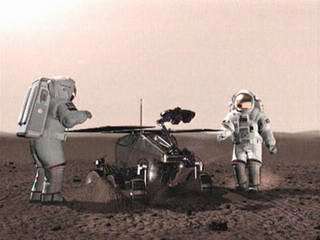Designing the missions of the future

Action station, an asteroid is threatening our planet! The menace is real and a rapid response must be found. At ESA's Technical Centre in the Netherlands, engineers believe that they have found the solution: hit the asteroid with a projectile to alter its trajectory enough to avoid disaster - that is the Don Quixote mission.
Image: The Concurrent Design Facility is working hard on future manned missions to Mars, part of ESA's Aurora programme
The Concurrent Design Facility (CDF), whose function is to conceive and design future space missions, was conducting this simulation, observed by the cameras of the EuroNews 'Space' magazine.
Another project the facility has been working on is a mission to explore Mercury, a planet with no atmosphere and for which a probe will have to fire retro-rockets and inflate an airbag system to land. The verdict of the engineers is that the project is technically feasible but costly with today's technology.
"We are working on missions which will be launched in 2030 and beyond," explains the head of the CDF, Massimo Bandecchi. "For example, missions to take people to Mars which require a lengthy development period."
The approach of the CDF is to use Concurrent Engineering (CE) to obtain a perfect synergy among all the specialists designing a mission before entering the industrial phase of the project. This approach is efficient and saves time.
"Concurrent Engineering is based on the simultaneous participation of all the disciplines involved," continues Massimo Bandecchi. "We ask our team to sit together and produce the design in real time. The final user of the mission, the "customer", is present during the design phase to ensure effective communication between engineering and scientific perspectives."
The "customers" are frequently the scientific teams who dream up new space missions. Peter Falkner, for instance, is envisaging sending a probe to Jupiter.
"Such studies require a lot of iterations of the basic design, because there is lot of inter-dependency between disciplines. If you change an aspect of, say the electrical power system, it influences the entire design. So it is extremely important that everyone is present in the facility so they can adapt their designs to changes in other systems."
All this requires the coordination of a Team Leader whose task is to ensure harmony between all the players, as Andrea Santovincenzo explains.
"This leader is the person steering the boat, bringing it back on course if it is going astray. He has the responsibility to conduct the process and to ensure a good interface between the customer and the engineering team."
All the resources of advanced computing are put to work, even a 3-D printer capable of producing a scale model of the spacecraft using the Computer Aided Design (CAD) files as input.
"We use this model to check visually that the design is correct and to show the team what their work looks like in three dimensions," explains Massimo Bandecchi, presenting one 'rapid prototype' model to the EuroNews cameras.
"This is a lunar lander with its descent module for landing on the surface. Then we have a habitation module where the astronauts will live during their stay on the Moon, and when their mission is finished, the capsule which will bring them back to Earth."
Returning people to the Moon is a goal that the European Space Agency is currently investigating, as well as journeys further afield which kindle the imagination and enthusiasm.
"The most interesting missions studied to date are the missions to Mars," says Andrea Santovincenzo. "This is because the missions are increasing in size, carrying more sophisticated payloads and instruments, and are becoming more complex."
Future Mars exploration missions are envisaged to continue with robotic reconnaissance missions within 5-10 years, followed by manned flights and then full-scale expeditions to explore the Red Planet. This perspective is outlined in ESA's Aurora programme, upon which the Concurrent Design Facility has been working for the last few years.
Source: ESA

















